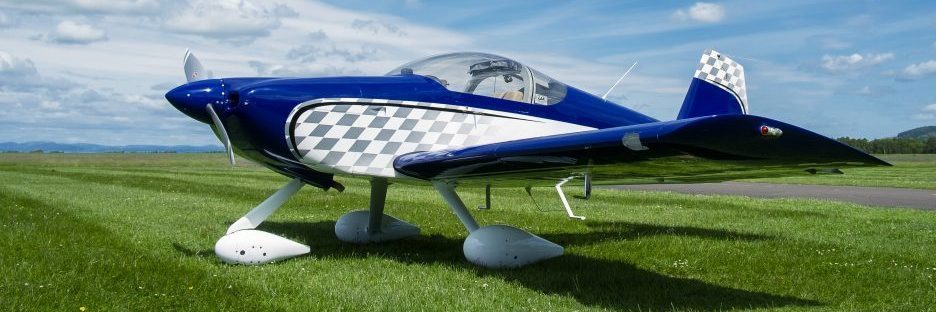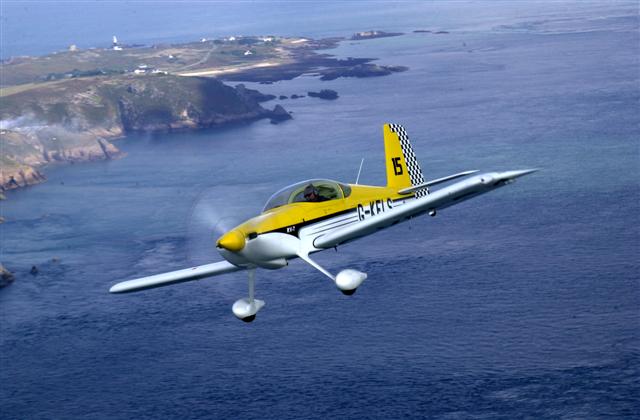
I’ve been Air Racing now for four years and every year it gets better!
I got hooked when I attended an Air Racing school which I saw advertised in one of the many aviation magazines I read cover to cover every month. I had some 100 hours on my RV6 and I’d done all the usual fly-ins and £50 hamburger runs. And I had now found something else to do with the aircraft I had spent three years building.
The Air Racing school was an introductory one-day course in Handicapped Air Racing. This was held in the “Squadron”, a wartime Nissen hut on the edge of North Weald airfield so steeped in history that you could almost feel the likes of Douglas Bader or Ginger Lacey sitting next to you.
I’d always been fascinated by the stories of the 1930s air races such as the Schneider Trophy and the bearing that those aircraft, particularly the Supermarine S6b were to have on the outcome of World War II. I had also long held a desire to at least see Air Racing in its modern form. The Air Racing School was to be run by Roger Hayes of Skysport and Geoff Boot an aviation writer and Air Race enthusiast. The day was extremely informative and when I saw the exciting videos of earlier Kings Cup Races I was hooked! My enthusiasm sparked, I had to have a go at this game for which I had the ideal aircraft in G-KELL, the Vans RV6.
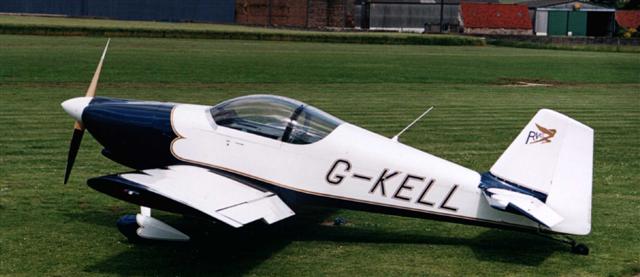
G-KELL, a VANS RV 6, built and raced by John Kelsall
The basic requirement to go Handicapped Air Racing is to have 100 hours P1, and an aircraft, which will fly at more than 100 mph. There are all types from Condors through Slingsbys to Beech Barons and Cessna 340s. Since I started racing the use of GPS as a tracking device has been introduced to both ascertain the flat-out speed of the aircraft during practice and during the race to provide a very accurate record of both the aircraft’s speed and its track over the ground.
The handicapper will take into account the weather and the wind on the day and then give each racer an allotted take off time relative to the first aircraft which is usually the slowest. If the handicappers have got their maths right and each pilot flies a perfect race then all aircraft should cross the finish line (usually on the airfield and in front of the crowd) together. In reality flight paths are not straight, aircraft climb and descend, and corners are cut thus spreading the field over maybe a minute at the finish.
The actual course flown can be a short course of maybe 4 laps of 25 miles to much longer international races.
Of course human nature being what it is people will try to “beat the handicapper”. This may be tried by deliberately flying slow on the practice laps or by flying a deliberately loose course. The application of something called the 1% rule is designed to combat this and so if a pilot turns in a practice run and then flies more that 1% faster than the average increase of the rest of the field during the race he renders himself liable to disqualification. Other things conspire to trip up the unwary race pilot and these can be anything from cutting a turning point to getting lost
My first race meeting was at Leicester in June 1999. It consisted of two races, one on Saturday, and would you believe it, the Schneider Trophy Race on Sunday. Practice was allowed on Saturday over a course, which consisted of four straight legs per lap, each lap being 26 miles long, and four laps per race. The turning points are marked by a 6foot orange pyramid topped by a yellow windsock placed in a field or roadside. The idea is to fly the quickest, and, therefore, shortest distance between these points.
After a check out ride by Robert Miller (one of only three check pilots), I was pronounced fit to compete. Having thoroughly studied the course, my navigator Glynn and I flew the practice and tried to memorise the ground features which would help us fly as straight a course as possible to each of the turning point markers. We also tried to asses what effect the strong southerly wind would have on our headings.
The race time arrived and we had been allotted a take off some 18 minutes after the slowest aircraft in the race, a Cessna 140 and five minutes before a trio of Beech Barons. Disaster struck when we found ourselves alongside and too far to the left of the first turning point marker. Since it is unsafe to orbit and regain the turning point marker once it is missed, one may as well drop out of the race or finish for fun. We continued to hopefully gain some experience for the Schneider Race on Sunday. We were duly eliminated for missing the first marker and warned that this would affect the result of the Schneider should we do well tomorrow.
Glynn was unable to attend for the Schneider so I asked the race organisers if they could provide me with another “pair of eyes” for safety. I was fortunate to be accompanied by a young lady called Safaya , a highly experienced race pilot who gave me some very helpful tips. The race started and we were off and running. Safaya was on my case immediately: “Don’t climb too steeply”, “You’re off track by 2 degrees left”, “Don’t descend”, I think I learned more in the 40 minutes it took to fly that race than I would have done in the next years racing. She kept my flying consistent and accurate and on the last two legs I overtook eight aircraft to cross the line at 100′ agl at 200 mph in FRONT of everyone else. I never expected that we would do quite so well and it was good to be congratulated even if it was to be short lived.
The handicappers cut our elation short<strong> </strong>by applying the infamous 1% rule which states that if one’s performance is better on the Sunday than it was on the Saturday by more than 1% of the average field improvement then you are liable to be disqualified. My average speed on Saturday was 167 mph and on Sunday 176 mph – 105%!
I don’t have a sideboard big enough for the Schneider Trophy anyway but I was grateful to Safaya and my new friends at the Royal Aero Club RRR for a great experience. I knew I’d be back for more. And I was – this time at Abbeville in France, in August.
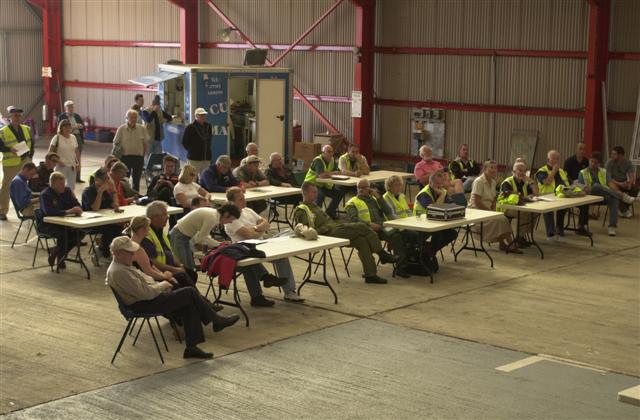
I flew over from Netherthorpe on a Friday afternoon in very clear conditions to arrive at Abbeville to find several other racers already there. The Royal Aero Club Records Racing and Rally Association (who arrange all the handicapped air racing) provided a bus to take us to our hotel. The next morning after a very enjoyable evening taking in the French hospitality the bus collected us and took us back to the airfield, after the renewal of old acquaintances and lots of coffee, the pre-practice briefing was held. Where the course is described in detail and safety issues are discussed. Then we were let loose on the course to find the turning points among the golden fields of the Somme.
The course is given on an ordnance survey map marked with a fine line and consists of five legs, at Abbeville the airfield turn has only a shallow angle between the two legs not the typical 80 -90 degree which racers round at very steep angles of bank and pulling 3-4G , very spectacular, all that was needed over the airfield was a slight waggle of the wings to change on to the new heading.
The practice over, it was time for the handicappers to do their calculations and issue start times for the 13 aircraft in the race. The first to take off exactly on the hour was a Condor, closely followed by a trio of Beagle Pups. Next came a Saab, a 172, a 182, a Robin and a Slingsby, before the little RV6. My time was 17 minutes and 44 seconds after the hour. The only aircraft behind me was a Beech Baron Twin G-DAFY that has a speed of 228 mph.
I watched the yellow Slingsby take off and keep very low along the runway, a runway pounded in an earlier life by the tyres of countless Messerschmitt 109s. At last he climbed to clear a wood and to be at 500′ by the time he reached the first turning point. I saw his bright yellow wings flash in the sun as he banked steeply to take up the second leg. My attention turned to the race officials and to the clerk of the course at my wingtip with his index finger up in my direction indicating one minute to go.
A quick mag check, apply carb heat, on and off, I start to build revs slowly when the starting flag is raised there are 10 seconds to go I apply full power and hold hard on the brakes. The flag drops, brakes off. I concentrate on keeping the nose in a straight line down the runway and gently let the tail lift. Still concentrating on keeping her straight I feel the vibration from the well-worn runway on the wheels disappear. We are airborne! Now the concentration really begins – don’t climb too quickly as this costs airspeed. I try to follow the lead given to me by Robert Miller in the Slingsby and arrive at the first turn at around 500′.
I’ve made mental notes during the practice as to where to find the turning point flags in relationship to the roads and woods immediately before I get to the turning point. The first one is after the big wood and just to the left of a small spinney at the edge of a field. There it is and I’m still too low! This means lost energy as the turning point marshals will make note that I’m not at a minimum height when I turn, and if I am too low I could be penalised.
I let the turning point and the marshals, who I can clearly see slide down the port edge of my engine cowl. When they pass under the leading edge of the port wing I apply 70 degrees of bank, pause for only a second and pull in the G. I look through the canopy and find the rollout point which I’d established in practice, and roll out as smoothly as possible onto track. The next leg is relatively easy as the track follows the edge of a long wood and my next turn is easily found at the near end of a long yellow field. Turbulence is quite severe and I tighten my harness still more to enable me to keep as close a control as possible on my height and course.
I manage a level efficient turn at the next turning point, all the time keeping a good look out for other aircraft. By now I have started overtaking the aircraft which took off first and I remember that I have to pass some of them again to beat them. The last leg of the first lap and I pass overhead the airfield and only have to make a slight alteration to course as the last and first legs are almost in line with each other.
The race continues and the engine purrs smoothly on. Full revs all the way round. I am assured that these Lycomings can easily take 2700 rpm all day, and indeed it does. The RV6 with 160 HP 0-320 is an ideal combination for this type of flying as at full throttle the speed in level flight remains just below the yellow arc, so I don’t have to worry about Vne busting. As I come on to the penultimate leg of the last lap I start to see lots of aircraft in front of me and caution is the watchword. See and avoid! It is the responsibility of the overtaking pilot to ensure safety and it is vitally important to stay level in a steep turn when there may be five aircraft turning round the same point at once.
I passed four aircraft on that leg, and on the final leg, the run-in to the airfield and finish line, I see the Beagle Pup of Geoff Boot and the Slingsby of Robert Miller in front. And I was going well.
As the trees on the edge of the airfield approached I passed the Pup, and the Slingsby slid underneath as well. I was in front. I suddenly thought of the dreaded 1% rule but remembered that it didn’t apply to this race. Had I really won? I landed and waited. People congratulated me and after maybe half an hour when all the turning point marshals had returned to the office with their observations the results were posted. I really had won, and legally too.
The race was over. I must have lost half a stone in the 40 minutes or so it took me to complete the 100-mile course, after all it’s akin to flying under the hot sun in a greenhouse. The adrenaline subsided and we relaxed to get ready for the wonderful social event that is also a major part of air racing.
There was a wonderful dinner that night hosted by the Somme Flying Club and I cannot praise the welcome we received too highly. I got to bed around 2.30 am.
Sunday was the Battle of Britain Trophy, aptly raced for here at Abbeville since it was formerly the home of the ‘Abbeville Boys’, a famous Me 109 fighter group during the Battle of Britain.
The race briefing was at 11.30 so I spent the time cleaning all the bugs off G-KELL and polishing the draggy bits. The race was to be over the same course so there was no practice and we were to start at 13.30 local. I was given a 39 second later start time which when I worked it out was later by some 15 seconds than the Slingsby. Ah well, c’est la vie. The handicappers rule OK! I’m assured that they are human. It is with no disrespect to the worlds great religions that one turns to the subject of handicapping. The Lord giveth and the Lord taketh away. It’s much the same with handicappers. Should they err in your favour, rejoice, if not persevere, they will get it right eventually.
Today my friend Phil was acting as my navigator and film crew all rolled into one. He was a little apprehensive and it took him well into the second lap to settle his nerves, after all the steep turns aren’t that aerobatic, are they? We again flew a really tight race without clipping any corners and keeping as straight as possible but the best we could manage was seventh. Still it was a very exhilarating experience and one which Phil thoroughly enjoyed.
The French really enjoy their flying and turned out in their hundreds to watch. It made us feel quite important to taxy back past waving crowds. The trophies were presented and I wished I’d had a bottle of champagne to spray over the assembled enthusiasts. Still, I suppose I wouldn’t want to fly home all sticky.
What an enjoyable weekend. From Friday afternoon to Sunday teatime I’d flown some 61/2 hours, some relaxing, some very testing, but all of it enjoyable. Roll on the next race at Shobdon.
That had been my first experience of Air Racing and the hook is still firmly embedded if fact since then I have analysed what I needed to try to improve my chances still further. I realised that the little RV6 had a fixed pitch prop which was a limiting factor so explored the possibility of fitting a Constant speed Propeller which would improve acceleration and therefore reduce the time lost due to getting back up to speed after a tight turn.
In the event I found that option a non-starter and since the new RV7 had recently been introduced, an aircraft which would easily accommodate a 200hp Lycoming I decided to build an entirely new aircraft and set off to Shawbury to view the RAF Bulldogs which the MOD were about to dispose of in an auction.
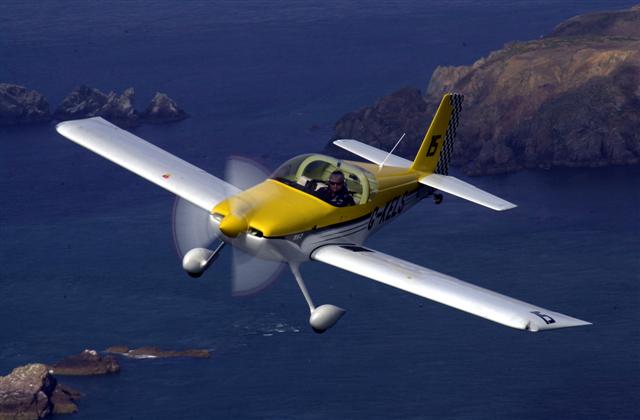
I managed to find a Bulldog which had a time expired airframe but an engine which was zeroed only 600 hour ago. The price was right and I became the proud owner of another aircraft.
Because the airframe had exceeded 114 on its fatigue index the good old CAA would not grant a permit to transit the aircraft back to Netherthorpe to take it to pieces. In the end I enlisted the help of a licensed engineer and we spent the day at Shawbury removing all the useful parts from the Bulldog to use on the new RV7 build. I managed to find buyer for the remains of the airframe and it made a good value engine and set of instruments.
The new Van’s kit is really superb its just like a big Meccano kit every rivet hole is pre-punched on a Computer controlled punching machine with spot-on accuracy. When the parts are assembled the airframe is straight true and square right out of the box! The kit arrived and I started building, since I had already built one RV I could easily recognise the parts and get into it quickly. I continued racing the RV6 and had a relatively successful year finishing in the upper half of the field with some consistency. By August I had found a buyer for the RV6 and he kindly allowed me to finish the season by competing in the Kings Cup at Leicester. I finished 4th. The RV6 was duly delivered to Shoreham its new home and I said goodbye to the best aircraft I had ever flown. A sad day!
The build continued with renewed vigour, I now had a target, to get finished before the new season started in May 2003. I decided that I would attempt the paint job myself as my usual paint wizard was about to become a father and Hospital visits are more important that painting an RV.
As it happened I took advice from an autobody re-finisher and used good quality materials and the magic ingredient, a measuring stick and the paint job came out really well.
May came and went and I stepped up the pace the first flight took place on June 13th and was followed by a strict test regime as it was the first one of type in the UK. Eventually I was ready a week after the Schneider!
My first weekend was at Carlisle and what a weekend, I managed a first place on both the Saturday and Sunday. The RV7 had arrived!
The RV7 is an ideal aircraft with which to race Handicapped air races and the use of a constant speed prop has made take-off and acceleration out of a corner a dream and the speed (201.8mph) is useful as it is easy to keep straight and turns very tight. As yet it is the only RV racing but hopefully more of the growing British RV fleet will take up the gauntlet. There is some impressive silverware to be won not least for the best performance in a homebuilt aircraft.
I’m still enjoying my flying. The RV7 is running really well and the racing is great fun. The social side is brilliant! With a dinner on most Saturday nights. The Royal Aero Club make newcomers very welcome and all help is given to anyone who cares to turn up.
Next season looks set to be a cracker with races taking place at venues such as Abbeville The Isle of Mann, the Isle of Wight, Goodwood, Compton Abbas, Shobdon and Alderney.
If your interested why not visit the Air racing website at www.airraceuk.com or call the air race secretary Mrs.Judy Hanson.
And if you do come remember the Air Racers old adage ‘Fly fast, Fly low Turn Left’;
